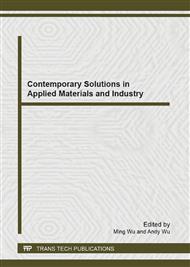p.20
p.25
p.31
p.35
p.39
p.44
p.49
p.54
p.59
The Prediction Model of the Mechanical Properties of Composite Materials Based on Ant Colony Neural Network
Abstract:
In this paper, a prediction model of the mechanical properties of composite materials has been proposed based on the ant colony neural network. The mechanical properties of the materials are the common problems that the various materials must be involved in the practical applications. The testing of the mechanical properties of the composite materials is of great significance to the development and the progress of the theory and the practice of composite materials. The ant colony algorithm takes advantage of the optimization mechanisms of ant colony, which has a strong ability to find the global optimal solution. The candidate group mechanism is added in the ant colony algorithm and the weights of the artificial neural network are trained through using the improved ant colony algorithm. This model has a strong adaptive ability and can be used in the prediction of the mechanical properties of composite materials. Then, the efficiency of the testing of mechanical properties can be improved.
Info:
Periodical:
Pages:
39-43
Citation:
Online since:
April 2013
Authors:
Price:
Сopyright:
© 2013 Trans Tech Publications Ltd. All Rights Reserved
Share:
Citation:


